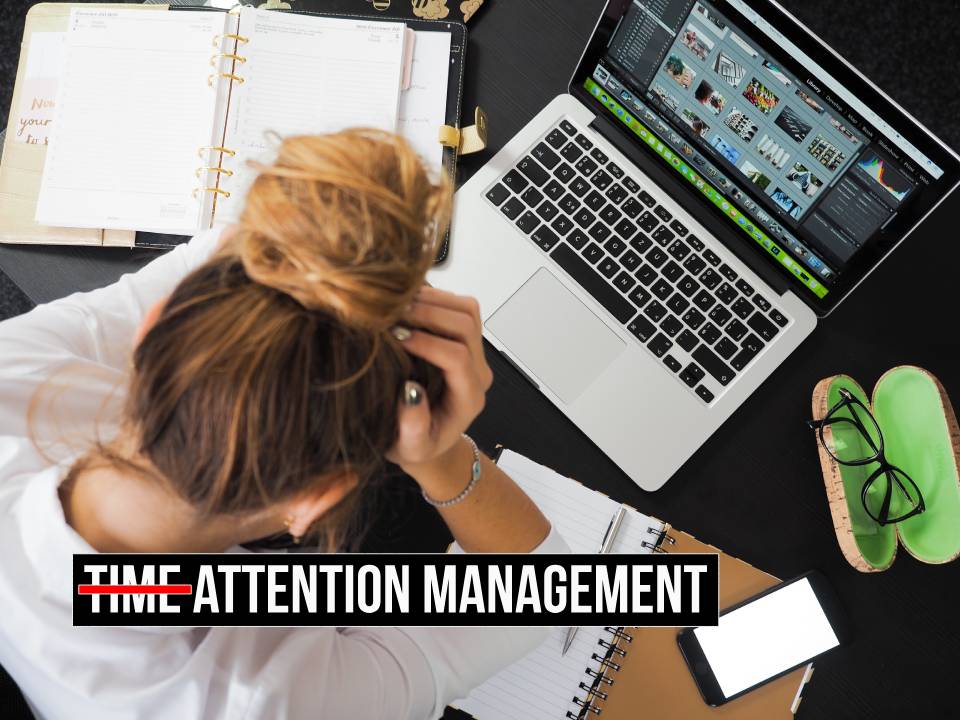If one of your new year resolutions is to start improving your time management skills, or if you’re interested in optimising your productivity, read on! In a world where our attention is constantly torn not only between people and projects but also devices, is time management really what we should be focusing on?
Arguably considered a cornerstone of a good work ethic, time management helps you to establish a routine, to set goals and track your progress over a work day. But does it prevent you from getting distracted by that juicy news article with celeb gossip or the incoming call from your friend on holiday?

In other words, is it your time or attention that is in the most jeopardy in today’s world? We take a look at an alternative to time management, focusing instead on where your attention is going.
What is attention management?
As the name implies, attention management takes into consideration the things that absorb our attention daily and looks at how managing that can help improve your productivity in a work environment. Here's how to focus on attention management:
1. Forget multitasking
Often touted as a skill, multitasking is certainly a big part of the self-employed life. After all, that next email could mean new business. Or it could be a push notification from that annoying app you downloaded and never opened.
While multitasking might seem like being super productive, recent studies have examined whether this is true. The truth is that multitasking means dividing your attention between different tasks, causing a lack of focus.
Multitasking is a major source of depletion when it comes to your attention. By focusing on something specific, giving it your full attention means higher efficiency and quality work.
2. Set your mission
Attention management takes some inspiration from classic time management in terms of prioritising. However, the prioritisation of tasks can result in a lengthy to-do list with tasks that seem hard to handle and can lead to something we’d all prefer to avoid: burnout.
Attention management takes a different approach in that it instead encourages determining your mission. That might sound a bit abstract, but it can be a major part of understanding what really needs to be prioritised and help you keep in mind why you’re working on it in the first place.
For example: John has started a graphic design business but he currently only has one customer. He worries about being taken seriously by other potential customers to be able to grow his business. He therefore sets his mission to expand his customer base, which means devoting more time to the tasks involved in that pursuit. This might mean doing a bit less work for his current client while he focuses on that aim.

3. The calendar and to-do list. 2.0.
Again, attention management isn’t about throwing the principles of time management to the wind, but rather how to improve upon in ways that will ultimately help your business (and your sanity).
So don’t worry, we’re not suggesting that you give up your to-do list. After all, there’s something inexplicably satisfying about crossing one thing after another off a long list.
What we are stating, however, is that you can upgrade. You can create a to-list to match your mission using a simple restructuring. For example, from the top down, your to-do list could be structured as:
- Main mission
- Useful extras
- Future plans
Allowing you to keep a prioritisation structure and to-do list but in keeping your ultimate current mission in mind.
When it comes to your calendar, this can be less easy to predict. Things often arise unexpectedly, especially when you’re self-employed, so it can be difficult to schedule them in.
For example: Heather has set a mission to become an established translator. She is working hard to finish a current project for a company, when she gets a call from a large company requesting a quote for a 3 week project.
Heather of course must finish her current project but had not counted on receiving such a request so suddenly. What’s the best way for her to manage?
One of the suggestions for managing a calendar more efficiently is: instead of scheduling in specific things, instead schedule in blocks of time. These free work blocks mean that you have set aside the time to work without specifying. This approach reduces the temptation to take free time, but also leaves you with more structure should unexpected work come up.
Of course, some tasks can be scheduled in more specifically, especially when it comes to important or required tasks with set deadlines (self-assessment tax returns, anyone?), the free work block approach can give you more flexibility in daily work.

4. Set limits for yourself
This is one that is not all that different from what you’ll find in effective time management guidelines: learn how to say no, take regular breaks, don’t neglect to take holiday time and completely disconnect from work.
When running a small business, some of these can seem almost impossible - can you really completely step away for a full weekend? What if your busiest period is over a holiday season?
Yet it’s crucial for your well-being (which in turn, is crucial for the well-being of your business) that you can say no to things that do not benefit your business. And this is where attention management comes in: keep your mission in mind and use it to determine whether it’s really necessary that you go to that conference, take that order, or attend that event.
5. Life hacks and other tools
With today’s distractions also come some very helpful tools for saving time on certain tasks and other ‘life hacks’ to help you increase your efficiency and prevent some distraction.
For example: do you find yourself spending time, several times a day looking for certain documents in that pile of papers on your desk? Scan them to your computer instead and use the ‘CTRL + F’ buttons to search for them quickly on your device or in the cloud.
Or, if your accountant asks for all of your business expenses from the past 3 months...instead of having to hand over a box of receipts, online accounting & invoicing software means your accountant can access the information they need, instantly.
Basically, don’t forget to take time to recharge your batteries. Being self-employed is certainly a marathon, not a sprint, and you need to be rested and healthy to better contribute to your business.
